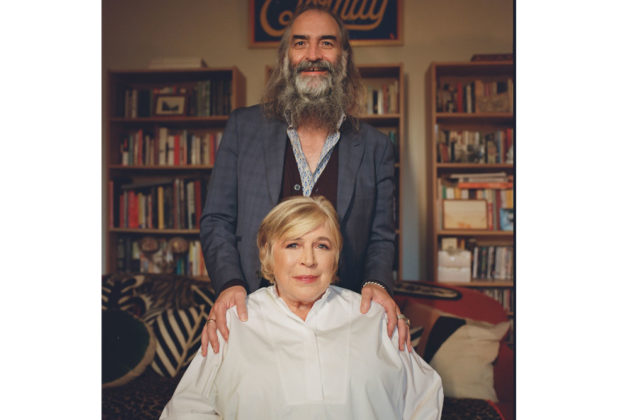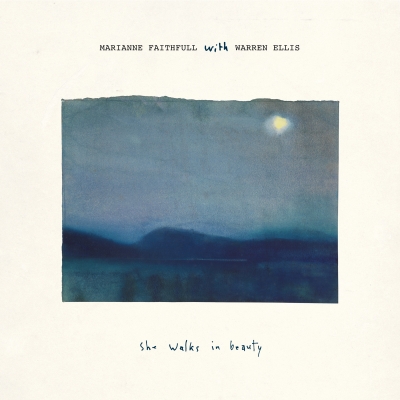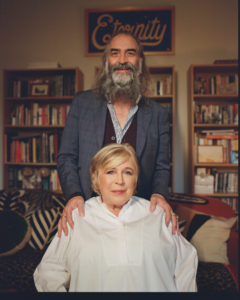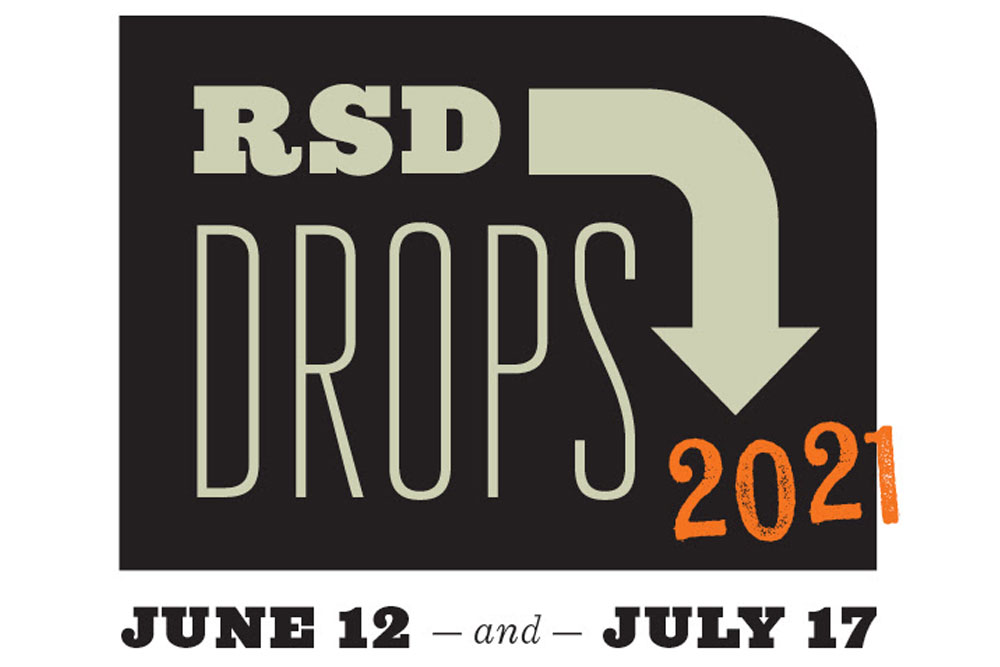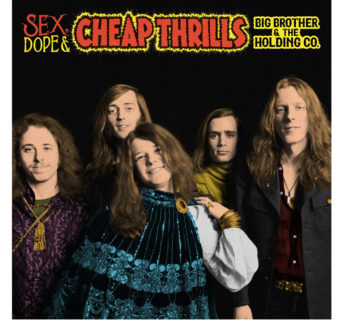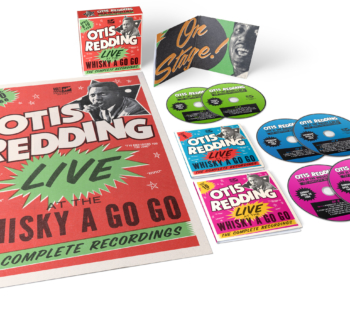On April 30, 2021, Marianne Faithfull, with composer and multi-instrumentalist Warren Ellis, will release She Walks in Beauty, one of the most distinctive albums of her long, extraordinary life and career.
Recorded around the earliest days of the COVID-19 lockdown — during which the singer herself became infected and almost died of the disease — She Walks in Beauty fulfills Faithfull’s long-held ambition to record a full album of poetry with music, and features musical friends Nick Cave, Brian Eno, cellist Vincent Ségal and producer-engineer Head (PJ Harvey, Thom Yorke).
She Walks in Beauty finds Faithfull drawing deep on the works of Shelley, Keats, Byron, Wordsworth, Tennyson and Thomas. Her vocal performances, set to Ellis’ subtle collages of sound, draw out the vibrant living matter in these great poems, renewing them with the complex, lived-in timbres of Faithfull’s voice. It’s both a radical departure and a return to her original inspirations as an artist and performer.
Ellis describes the music of She Walks in Beauty as a kind of musique concrète, incorporating street sounds with a range of acoustic and electronic instrumentation and manipulation.
“My preferred way of making music is to leave a lot of it to chance, to let accidents happen,” he says. “I’ve been moving away from structures in things. This music is me attempting to push forward. I think it’s as good as anything I’ve ever done,” he adds, “in terms of the spirit of it and the process I went through to make it.”
That process would eventually come to include contributions from Nick Cave, who played piano on many of the tracks; Brian Eno, who created sound textures for “La Belle Dame Sans Merci” and “The Bridge of Sighs”; and Vincent Ségal, who added cello to Shelley’s liminal, otherworldly “To The Moon,” and Byron’s late night lament “So We’ll Go No More A Roving,” among others.
Faithfull first developed a passion for the English Romantic poets in her A Level studies with one Mrs. Simpson at St Joseph's Convent School in Reading, before leaving for London at the age of 16.
She has returned to poetry for inspiration many times since: whether on 1979’s Broken English, an album which featured her setting to music Heathcote Williams’ poem of eviscerating rage, “Why’d Ya Do It,” or on subsequent albums, such as 1995’s A Secret Life, which featured the poems of her friend Frank McGuinness, or 1998’s Seven Deadly Sins which explored the work of Kurt Weill and Bertolt Brecht.
Still, the works chosen for She Walks in Beauty hold special pride of place. “I wasn’t in doubt,” says Faithfull. “I’ve been thinking about it for so long, this album, it’s been in my head for so long, I think I really knew exactly what I wanted. I just picked the poems I really loved, and I can’t help but say I think I was very lucky. We got it.”
She Walks in Beauty Tracklist:
She Walks in Beauty (Lord Byron)
The Bridge of Sighs (Thomas Hood)
La Belle Dame Sans Merci (John Keats)
Ode to a Nightingale (John Keats)
Ode to Autumn (John Keats)
Ozymandias (Percy Bysshe Shelley)
From The Prelude (William Wordsworth)
Surprised by Joy (Williams Wordsworth)
To the Moon (Percy Bysshe Shelley)
So We’ll Go No More A Roving (Lord Byron)
The Lady of Shalott (Lord Tennyson)
In an April 4, 2020 Hollywood Reporter story Alex Ritman reported the news “McQueen Director to Helm Marianne Faithfull Biopic With Bohemian Rhapsody Star Lucy Boynton.”
Ian Bonhôte who helmed the acclaimed Alexander McQueen documentary McQueen, is now slated to direct the biopic Faithfull, starring actress Lucy Boynton confirmed for the lead role. Julia Taylor-Stanley (Coriolanus) of Artemis Films and Colin Vaines (Film Stars Don't Die in Liverpool) of Synchronistic Pictures producing.
According to The Hollywood Reporter, the movie will depict “the star's roller-coaster journey from being discovered as a convent schoolgirl of 17, finding fame as a pop idol, living through hedonistic times and a tumultuous romance with Mick Jagger that inspired some of their greatest songs, to being a homeless drug addict in Soho.”
“I am delighted that my story is finally being made with my dream team of Lucy, Julia and Ian,” said Faithfull in a statement.
In my few encounters with Marianne over the decades, and long interview in Hollywood at the Chateau Marmont hotel in 1995, we always discussed beat generation poets and counter-culture figures, and I’m so glad she delivered this long-awaited poetry collection.
Her 1994 Faithfull: An Autobiography, written with David Dalton, and hopefully this upcoming biopic will depict a real-to-reel survivor’s tale.
Marianne’s catalog includes 20 albums in her career. A 2018 effort on BMG, Negative Capability, has collaborations with Keith Richards and Nick Cave.
Earlier this century ABKCO Records issued a collection of Faithfull’s songs of the ‘60’s, Marianne Faithfull’s Greatest Hits, spotlighting “As Tears Go By,” “Summer Nights,” “Come Stay With Me,” “This Little Bird,” and “Sister Morphine,” which she co-wrote with Mick Jagger and Keith Richards.
In 2000 I discussed Faithfull with her first record producer Andrew Loog Oldham, the 1963-1967 record producer and manager of the Rolling Stones, for Discoveries magazine.
“The fact is forgotten that Marianne had, between August of ‘64 and the summer of ‘65 four Top Ten hits in the UK. ‘As Tears Go By’ and ‘Come And Stay With Me’ held up.”
“As Tears Go By” is a song penned by Mick Jagger, Keith Richards and Andrew Loog Oldham. It reached a top ten position in the UK singles chart. The Stones then recorded their own version, included on the American pressing of December’s Children (And Everybody’s) in 1965. Their American record label London issued “As Tears Go By” as a single that landed in the number six spot on the Billboard Hot 100 singles chart. The Rolling Stones subsequently performed the tune on an episode of The Ed Sullivan Show.
In 2016 author and deejay Oldham further elaborated about the 1963-1966 music business in England.
“For one it was obvious that ‘this thing of ours’ was not going to disappear. We had come in following the Twist, Davy Crockett, Skiffle, and Trad Jazz. Skiffle and Trad Jazz had been very important; they had been the BBC and the Establishments last chance to control the key to what music we got to hear.
“There were villains, there was mayhem, action and if we had not had Pirate Radio I might not have had a hit with Marianne Faithfull's ‘As Tears Go By.’ The BBC would not touch it. They said Marianne could not sing.
“Mind you, that's what they'd said about Mick Jagger a year earlier when the Rolling Stones failed their BBC live audition. They said ‘The singer cannot sing.’ The BBC was the enemy, a limp wristed arm of the government trying to keep kids on a rationed musical diet of trad jazz and skiffle.”
In the 2012 Rolling Stones documentary, Crossfire Hurricane, directed by Brett Morgen, produced by Mick Jagger, Victoria Pearman, Keith Richards and Charlie Watts, Jagger acknowledged his influence for the composition was informed from French poet Pierre Baudelaire and the Russian author Mikhail Bulgakov’s novel The Master and Margarita. An English translation was made available in 1967.
It was Marianne Faithfull, who gave Mick the book which inspired “Sympathy for the Devil.”
It’s heard on Beggar’s Banquet, produced by Jimmy Miller and engineered by Glyn Johns and Eddie Kramer in London at Olympic Sound Studios. “Sympathy for the Devil” started on June 4, 1968 and continued the next day. Overdubs were added during June 8th-10th.
Session personal for those dates were: Mick Jagger, lead vocals; Keith Richards; bass guitar, lead guitar, backing vocals; Bill Wyman, maracas and background vocals; Brian Jones, acoustic guitar and background vocals; Charlie Watts, drums, cowbell and backing vocals; Rocky Dzidzornu, congas; Nicky Hopkins, piano and backing vocals, Anita Pallenberg and Marianne Faithfull, backing vocals.
In 2018 ABKCO issued The Rolling Stones Rock and Roll Circus on DVD, a landmark 1968 event directed by Michael Lindsay-Hogg just prior to directing the Beatles Let It Be.
One of the highlights is Marianne Faithfull singing “Something Better,” a Barry Mann and Gerry Goffin tune, arranged by Jack Nitzsche and produced by Mick Jagger. Charlie Watts introduces Faithfull on screen.
In a 2019 interview I asked Michael Lindsay-Hogg about Marianne’s sequence in the film and his sweeping directorial pan displayed.
“It goes back to the song,” he stated. “It goes back to Marianne and the years when she and Mick were going out together. She was a beautiful girl with a lovely figure. And she was the only girl except for Yoko Ono.
“Marianne appeared and I thought ‘this has to be about her and the camera work,’ a one of a kind beauty. And the way Tony Richmond lit her with her hair on her face. She was a beautiful young woman. It was partly celebrating her. And, then there is that long musical break where the camera circles around and ‘what would we cut away too?’ And so I thought ‘let’s do the unusual thing of just holding on her when she is not singing. Just move the camera around.
“I also wanted contrast with her because there were a lot of men on the show. Everyone on the show, except for Yoko, were guys. At the time there weren’t a lot of women in the rock ‘n’ roll world yet. There was wonderful Dusty Springfield, but mainly guys.”
In the early ’90s she was made a professor by Allen Ginsberg at the Naropa Poetry Institute in Colorado, where she has taught lyric writing. Her certificate reads: Marianne Faithfull, Professor Of Poetics, Jack Kerouac School Of Disembodied Poets.
During 1994, Marianne Faithfull had a new album out, A Secret Life, a collaboration with producer/arranger /co-writer Angelo Badalamenti, (best known for his working relationship with filmmaker David Lynch, including orchestrating the music for Twin Peaks).
Island Records at the time also released Faithfull: A Collection Of Her Best Recordings, and in 1994, Little Brown published her candid terrific memoir, with David Dalton, Faithfull: An Autobiography.
It was Allen Ginsberg, who encouraged me to look Marianne Faithfull up the next time she was in Hollywood.
During 1995 Faithfull had just done a show at The Henry Fonda Theater on Hollywood Blvd in 1995. “Go talk to her and let her talk to you,” A.G. suggested.
I was given an interview assignment for HITS magazine. Marianne’s publicist at Island Records arranged for me to visit her on Sunset Blvd. at the Chateau Marmont.
In 1995 I knocked on the door to Marianne’s hotel room at the Chateau Marmont, ironically, right next to the suite where years earlier I had interviewed and had lunch with Leonard Cohen.
Marianne answered my knuckles, “Welcome to the poet’s corner,” she beamed.
I looked at her for about 30 seconds. She has big green eyes. Clad in black. Not punk black, but black blouse, black pants and black nylons.
Marianne was an image out of Hollywood’s Jazz City music club circa 1958, a cinema noir sister of Susan Oliver and Gloria Grahame. She wore no makeup, blonde, long hair, a little zaftig, shorter in person that I expected.
Marianne has a dancer’s body. In fact, twice during the two-hour chat, she leaped off the couch onto the rug and sort of did a move, an interpretation of “the sideways pony” dance that Tina Turner once taught Mick Jagger in the hall way in front of her in 1965 at Colston Hall in Bristol, England. She told me her mother Eva taught her to dance as a child.
I then mentioned that I briefly danced on American Bandstand as a teenager.
She was rather impressed.
“Whew…Remind me to give you a kiss and a hug when you leave today and don’t worry if my boobs get in the way,” she comically warned. “No problem,” I assured her.
Room service delivered Marlboro Lights. Marianne also ordered a vodka martini for our smoky conversation. I had a mineral water. The record label paid.
Marianne was very supportive to me when I complained about not getting a book deal. A decade later she had a chapter in my first book This is Rebel Music, published in 2004.
This still alluring Marianne Faithfull turned out to be a fascinating interview subject and a real yenta. She was a lot of fun and never avoided a question during our time together.
A portion of our interview appears below, which in some ways partially explains the origins of her She Walks In Beauty music and poetry endeavor.
Q: I got from your autobiography you were a poetry head.
A. Always. That’s one of the reasons I love Allen so much and William Burroughs.
Q. Needless to say, one of the things that drew you to the music and word work of Bob Dylan. I noticed you were in one of the hotel room scenes in Dylan’s Dont Look Back film that chronicled his 1965 British tour.
In your book in the Dylan Redux chapter, you provide a real cool glimpse of Dylan in action in the mid-60’s and then years later. I thought it was one of the sections where you and David Dalton worked really hard in bringing the moment to the reader.
A. I think that was the bit that David did best. I didn’t work the hardest on that, David did. But it was wonderful. I wish he’d written the whole book like that. And all the Bobby Newirth stuff was so beautiful.
Q. Had you never seen a rock person like Dylan or an American like him in 1965?
A. Never. Never in my wildest dreams could have imagined anyone like Bob in 1965. His brain, but I was frightened. I didn’t know they were probably more scared of me. I don’t know. They were all on methedrine. He played me the album Bringing It All Back Home himself on his own. It was just amazing. And I worshipped him anyway. That was where I got very close to Allen Ginsberg ‘cause Allen was the only sort of person I could recognize as being somewhat like me.
Q. I really enjoyed the passage in your book when Allen came to London with the Italian poet Giuseppe Ungaretti. They read at Queen Elizabeth Hall. You had spent some time with Ginsberg during Dylan’s Dont Look Back tour and I laughed out loud as you described inviting Allen to the house you shared with Mick Jagger. Great image and a very fortunate position for you as Ginsberg sat on your bed with you and Mick naked under a fur cover.
As you put it, “Allen, as usual, was on a mission. Allen was trying to get Mick to put William Blake’s ‘The Grey Monk’ to music.” Again, until this book, I never knew you had such a jones for poetry, and beat generation poets.
A. (Smiles). I find them very sexy all those guys. Wonderful. I teased Allen in my book. I adore him. The first time I went to Naropa, Allen was literally by my side like he is. There was a lot of criticism and “Who is the woman?” “Why do you (Allen) think she can do this?” And he didn’t say anything. “I just do.” And then I came back again. We are very good friends. He also represents a lot of things for me that aren’t part of our friendship or our relationship. He is the greatest living American poet. I hooked Allen up with [producer] Hal Willner.
Q. How did your autobiography come together? I know you’ve been approached over the years and obviously film adaptations are being offered on this book and your life.
A. It took a long time. I have great recall.
Q. Why did you do the book?
A. I did it for you. (laughs). I did. I felt there was something in the story that was very common to everybody. I do believe that the details and the individuals are different, but the emotions and the sort of core thing are very, very connected to all human experience. Therefore, I felt it was a valid story to tell. And then again, I felt I was very close to some of the greatest people of my time. And I had a lot of help.
David Dalton came to Ireland for two weeks. He’s a very shy person. He selected me. Such a strange story. Tony Secunda, who recently died, I dedicated my paperback English edition to him, he had become a literary agent, and he was working with Dalton and he came to Ireland. I didn’t want to do this book, really. Much as I care for humanity…
I knew it was going to be a really hard thing to do and it took a lot to get me to do it. Tony came to Ireland first to talk to me. It needed that. He really made me realize that it was very serious to get an offer from Little Brown Publishing and Michael Joseph is very serious, and this was not the moment that I could do my flouncy “Oh no” sort of thing. Secunda had managed me for a little while just after Broken English. I was very fond of Tony.
“What I realized about Tony coming to Ireland, and it’s a very unique thing that happens very rarely, but it happens to me quite a lot, actually. Tony was making amends and he negotiated for me a book deal you could not believe. To Dalton’s fury, who was also David’s agent, insisted was that the deal favoured me. We had had this history and he was making up for that. He came out of this very honorably and he suggested David, who I’ve ended up very close friends with. By then I realized that Tony was on the level.
Q. And he picked David Dalton who was a big Rolling Stones fan.
A. That was peculiar for me. And my great tease. I would tell David at first, that what I saw in him as a writer was that he was basically a necrophilliac. “You have only written books about dead people. (James Dean, Janis Joplin, Jim Morrison). How are you going to cope with someone who is not dead and not likely to be dead?”
Q. And being a woman with opinions.
A. But David liked that.
Q. But I’m sure you also gave a view and observations of your life and art process that were different than the myth and history events captured so far in the Rolling Stones documentation.
A. It took him a long time to believe me. I have to stand up for David because it wasn’t as simple as that. Yes, he was a Rolling Stones fan, but that in itself shouldn’t be a problem.
The interviews went on for hours. It was so dreadful. Those first two weeks we would start in the morning. David would sit there and ask me. He’s kind of conservative but a loon. He didn’t know me at all. He came up with all the preconceptions that everybody else does. It was Ellen Smith, my press agent, who said to me, “Think of him as everyman. He’s just coming to you with everybody’s preconceptions. Think of him as everyman.”
Q. And for once, you had the opportunity and forum to tell your side of the story. The truth you saw and experienced. You were in control.
A. Well I didn’t realize that, ya know. That’s what made it so hard for Dalton. He kept saying to me, “This is your book! This is your thing! I will only do what you want.” But I didn’t believe him.
“The first two weeks were a nightmare. He would sit there and say “Marianne, what exactly happened and what were you doing on March 10, 1965?” Didn’t work at all. Then he got into despair. After two weeks I remember the taxi came to take him away and I said goodbye to him and it was so typical of the way I am, and Allen (Ginsberg) knows this backwards, as Dalton was leaving my house, after we toured the castles of Ireland and he met my friends, his mind had been completely blown.
I had been very funny and told lots of stories. But at the very end, just sorta in my way, “Well David, you do know these are just my ‘party pieces.’” And on that, poor bastard, he went back to the states.
So he was in despair. So his next thing was that I would take ‘truth serum.’ Sodium Penathol . (laughs). He had some serious preconceptions. And he thought I was lying. (laughs). So for three years, two years in, suddenly it all fell into place.
Like I would tell him a story like Dylan Redux, and he did not believe it. And then Demelza came up from Cornwald, I hadn’t seen her in 15 years. She walked in to my brother’s house. She sat down and told him without even consulting me exactly the same story. So then Dalton began to realize I was telling the truth.
Q. Was it your intent in the book, and specifically this Dylan chapter to be so detail oriented about the environment? Obviously, you were doing a memoir. I know for a fact there are some scenes that went down that you could not invent unless you were there. And, I even feel it on the printed page.
A. Of course, I was there! I ended up adoring David. He’s one of my best friends now.
Q. Did photos trigger recall of events?
A. No. I‘ve been carrying this around for a long time. And I had remembered the things that were important to me which were always the same. It was always very, very clear that what I was really interested in and always had been interested in was motive and psychic position and why. There were a million things I could not remember, which are not interesting to me.
Like most of the time I don’t remember what people were wearing. I remember what Allen was wearing, because often, Allen would take his clothes off. So, I would know that and understand that. I would see Allen clothed and unclothed. And that’s a very simple situation. And I remember one thing, I think is the White Ball and the black dress. So it’s only on very clear demarcations like clothed, unclothed, black, white that I really know exactly.
Now Anita (Pallenberg) actually remembers things only through what we were wearing, ‘cause that’s what she’s interested in. I don’t mean that as a put down. But that’s how she remembers things. When I say, “Do you remember such and such a day…?” The way back for Anita is ‘Oh yea... You were wearing a red velvet …and I was wearing…’” You’d dig her, man.
Just let me say, the best work David and I did was on the telephone, which I think is very fascinating.
Q. Can you be more honest over the telephone?
A. I’ll tell you, exactly. Did you ever read The Art Of Memory.
Q. No.
A. I read it so I knew that there was a real key to this thing. And eventually, I suggested to David that we would choose a time of day, because we weren’t getting anywhere. Around 7:00 p.m. in the evening, my time. I was in Ireland and he was in New York. I went about my day, and I went for my walk and I had my lunch and I do my little things, not think major, you know, just my little life. And all day I would be thinking about the time period we were in.
Every night at 7 o’clock I would call Dalton and he would put the little machine on into the phone, and I think that not seeing him, and not having another human being, and being on the phone, which is something I learned from being in the programme, how to use the phone. And that would really free up a lot of …And the fact that all day I had been thinking about it and I knew as the weeks and the months would go by that I always knew where we were. I write long hand with pen on legal paper. Helps memory. The real stuff.
Q. What was it like seeing the galleys? The first typeset manuscript?
A. That was heavy. (sighs). That was when I also saw the pictures. My editor came over with the pictures. That was one of the harder bits.
Q. Did you take things out at that point?
A. Yes. It wasn’t legalities. There were some mistakes and I could not have them.
Q. Was it hard during the interviews and the collaboration with David Dalton to tell your point of view? I would imagine you had to at times be combative.
A. Yes. I thought it was really good for me and about fuckin’ time I learned to do that. I didn’t want to. I resisted it but I had to. I had to. David is married to a very intelligent woman Coco and she really worked very closely with him and I think it had some impact. It was much harder work than David had ever done before. A living person.
Q: In your book you mention some of the Rolling Stones characters in their songs came to life partially owing to acid.
A: Of course they did. I don’t think acid is relative or relevant anymore. I wouldn’t do it again. But I think that it was important then, and I think it taught us a lot.
They were all very much in love with me at that time. Not only me, but I was one of the many women they were in love with. Keith and I are still very close. I’m under his wing and I know I will always be under his wing.
Brian wasn’t as bad as everybody thinks. Well Brian was a genius but he was a very irritating person. Keith really loved Brian. I use Brian. I have a whole lot of friends on the other side that I call up when I need them. I use Brian, Janis and now I’ve got Tony Secunda and Denny Cordell.
I cut out some things about Brian Jones. He went on and on and made him much more of a worse person than he was. He could only do that really because he was dead. He couldn’t go on and on about Keith and Anita or even me because I did the classic Buddhist thing: I just did a drive all blames into one. I made that decision. That is something I learned from Allen. I’ve had good Naropa training. The galleys were hard to read.
Q. What is it like looking and reading the book?
A. I’ve read it and re-read it and it’s still hard…It’s hard to believe I’ve done it and that it’s really me and a part of me now. David did a good job, man. I have to say this.
Q. Your book is now out in paperback. I just got a copy. Do you have any more feelings on it since publication?
A. I’m terribly pleased with it and proud of it. It’s like a child of mine that has gone out and done well. It’s a good read.
Q: As a teenager in England you went to a Catholic School St. Joseph’s in Reading. And devoured a lot of books and studied poetry. But in your autobiography I learned you’re Jewish.
A: My dear little Piscean, my mother and my grandmother were Jewish. My mother came from a line of Austro-Hungarian aristocrats. My mother was a doctor’s daughter. She was a Jewess, those great Jews who went out and did it from the Austro-Hungarian Empire. Doctors, writers, sort of like going into Oklahoma. Allen Ginsberg now is my Jewish Mother.
Harvey Kubernik is the author of 19 books, including Leonard Cohen: Everybody Knows, published in 2014 and now available in six foreign language editions. Kubernik also authored Canyon Of Dreams: The Magic And The Music Of Laurel Canyon and Turn Up The Radio! Rock, Pop and Roll In Los Angeles 1956-1972. Sterling/Barnes and Noble in 2018 published Harvey and Kenneth Kubernik’s The Story Of The Band: From Big Pink To The Last Waltz. For 2021 the duo has written a multi-narrative volume on Jimi Hendrix for Sterling/Barnes and Noble.
Otherworld Cottage Industries in 2020 published Harvey’s book, Docs That Rock, Music That Matters, featuring interviews with D.A. Pennebaker, Chris Hegedus, Albert Maysles, Murray Lerner, Morgan Neville, Dr. James Cushing, Curtis Hanson, Michael Lindsay-Hogg, Andrew Loog Oldham, Dick Clark, Ray Manzarek, John Densmore, Robby Krieger, Travis Pike, Allan Arkush, and David Leaf, among others.
Kubernik’s writings are in several book anthologies, most notably The Rolling Stone Book Of The Beats and Drinking With Bukowski. Harvey penned a back cover endorsement for author Michael Posner’s book on Leonard Cohen that Simon & Schuster, Canada published in October 2020, Leonard Cohen, Untold Stories: The Early Years.
This century Kubernik wrote the liner note booklets to the CD re-releases of Carole King’s Tapestry, Allen Ginsberg’s Kaddish, Elvis Presley The ’68 Comeback Special and The Ramones’ End of the Century). Harvey is the Project Coordinator of The Jack Kerouac Collection, a box set of recordings.
In summer of 2019, Harvey was interviewed for director Matt O’Casey on his BBC4-TV digital arts channel Christine McVie, Fleetwood Mac’s Songbird. The cast includes Christine McVie, Stan Webb of Chicken Shack, Mick Fleetwood, Stevie Nicks, John McVie, Heart’s Nancy Wilson, Mike Campbell, Neil Finn, and producer Richard Dashut. Premiere broadcast was in 2020.
During 2020 Kubernik served as a Consultant on the 2-part documentary Laurel Canyon: A Place in Time directed by Alison Ellwood. Kubernik is currently working on a documentary about Rock and Roll Hall of Fame member singer/songwriter Del Shannon.
Kubernik also appears as a screen interview subject for director/producer Neil Norman’s GNP Crescendo documentary, The Seeds: Pushin’ Too Hard. Jan Savage and Daryl Hooper original members of the Seeds participated along with Bruce Johnston of the Beach Boys, Iggy Pop, Kim Fowley, Jim Salzer, the Bangles, photographer Ed Caraeff, Mark Weitz of the Strawberry Alarm
Clock and Johnny Echols of Love. Miss Pamela Des Barres supplied the narration. Norman’s documentary is scheduled for a debut broadcast on television during 2021.
This decade Harvey was filmed for the currently in-production documentary about former Hollywood landmark Gold Star Recording Studio and co-owner/engineer Stan Ross produced and directed by Brad Ross and Jonathan Rosenberg. Brian Wilson, Herb Alpert, Richie Furay, Darlene Love, Mike Curb, Chris Montez, Bill Medley, Don Randi, Hal Blaine, Shel Talmy, Don Peake, Kim Fowley, Johnny Echols, Gloria Jones, Carol Kaye, Marky Ramone, David Kessel and Steven Van Zandt have been lensed.

